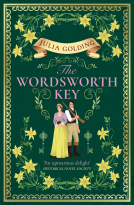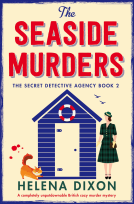
Death Stops the Frolic
by George Bellairs
This title was previously available on NetGalley and is now archived.
Send NetGalley books directly to your Kindle or Kindle app
1
To read on a Kindle or Kindle app, please add kindle@netgalley.com as an approved email address to receive files in your Amazon account. Click here for step-by-step instructions.
2
Also find your Kindle email address within your Amazon account, and enter it here.
Pub Date 19 Mar 2020 | Archive Date 27 Apr 2020
Talking about this book? Use #DeathStopstheFrolic #NetGalley. More hashtag tips!
Description
Before there was Littlejohn, there was Nankivell.
With his classic wit and trademark style, George Bellairs delivers this standalone mystery sure to keep you guessing.
And when they’re up, they’re up-up-up, And when they’re down, they’re down, And when they’re half-way up…
On a joyous afternoon filled with tea and cake, something strange happens at Zion Chapel’s Anniversary Tea Party. The infamous Alderman Harbuttle is behaving uncharacteristically playful – laughing with the assembly, singing rhymes, and leading people in a rousing game of Follow-My-Leader throughout the chapel’s winding halls.
But his jubilee is cut short when the revellers find the Alderman’s murdered body in the dark recesses of the chapel, a bread knife buried to the hilt in his chest.
Superintendent Nankivell of the local police force takes up the case, and his investigation quickly stirs up sinister secrets lurking within the walls of Zion Chapel. His suspect list soon proves massive, as he learns there are many people who would be happier without the sanctimonious Alderman Harbuttle around…
Death Stops the Frolic was first published as Turmoil in Zion in 1943.
A Note From the Publisher
If you enjoyed reading Death Stops the Frolic, we'd really appreciate seeing your honest review on Amazon. Thank you and happy reading, Agora Books.
Available Editions
| EDITION | Ebook |
| ISBN | 9781913099114 |
| PRICE | £3.99 (GBP) |
Links
Featured Reviews
 Heather R, Reviewer
Heather R, Reviewer
My thanks to the publishers for providing me with a copy of this book in exchange for an honest review.
Mr Harbuttle, self made grocer, property speculator and town dignitary, reaches his personal Pisgah through the upper storey trap door of the Zion Chapel with a bread knife through his heart. His demise brings another murder in its wake in a new edition of this George Bellairs charmer set in wartime Britain in the improbably industrial yet religious town of Swarebridge. It's a good read for a winter evening by the fire.
Bellairs' cinematic eye and gentle parodies of small town life and its people entertain. Unusually, we are not with Littlejohn this time but with the equable Superintendent Nankivell. Urgency is not in his nature but then the joy of Bellairs is not in a clever, paced plot or in the unravelling of a precisely involved and carefully clued puzzle. He is not a giant of literature either. But his portraits of people stay with you and, while some, mainly wealthy and corrupt, are caricatures, most are sympathetically drawn. Consider the exiled Swiss baker in this story or the diminutive Miss Sleaford with her framed portrait of the soldier who passed through and provided her once in a lifetime romance before, we are told, surviving the war and growing fat and abusive to a wife elsewhere.
Of course and as usual, the avuncular Bellairs misses no opportunity to lament 'the gracious old and the hideous new', although today, in our turn, we might view the chromium and imitation tailors with nostalgia.
I enjoyed this book and was pleased to see it also contains a tantaliser for 'He'd Rather Be Dead' about the murder of another self made petty potentate and I look forward to reading the rest of that one too.
 Reviewer 266180
Reviewer 266180
Who Killed The Alderman?.....
An early Bellairs (first published as ‘Turmoil In Zion’). No Inspector Littlejohn here but rather the equally empathetic Superintendent Nankivell. Superbly written and perfectly observed, a larger than life cast of characters and laced with dry wit. Excellent reading.
 Simone V, Reviewer
Simone V, Reviewer
I have been a fan of George Bellairs novels for several years, ever since I discovered Inspector Littlejohn. This novel doesn’t feature Littlejohn, but rather the equally talented Superintendent Nankivell. I really enjoyed this novel, although initially I was a little put off by the change from first person/present to the more familiar third person narrative that characterized the first chapter or two. Once I got used to that, I found this an easy to read novel, that held my attention.
I’ve come to expect interesting characters and witty observations about everyday life from this author and this novel didn’t disappoint in that regard. It begins by picturing much of the village population at a celebration of Zion Chapels anniversary. We are introduced to the main characters and soon learn something about their lives, their relationships, and their secrets. The party ends on a sour note, with a very unexpected murder. Superintendent Nankivell takes on the case and ends up solving more than just the murder.
Highly recommended.
Thanks to Agora Books and Netgalley for allowing me to read and review.
 Librarian 431790
Librarian 431790
George Bellairs never fails to deliver and I'm never disappointed by his books even if I have very high expectations.
This is an excellent stand alone story with a great description of village life and a solid mystery.
The cast of characters is fleshed out and the description of the historical background is vivid and realistic.
One note: some observation can be a bit un-politically correct but this is part of the time mindset.
I was an excellent read that I couldn't put down, highly recommended.
Many thanks to the publisher and Netgalley for this ARC, all opinions are mine.
 Lucy T, Reviewer
Lucy T, Reviewer
I am a longtime fan of George Bellairs' Inspector Littlejohn novels. Death Stops the Frolic is an early work and does not feature Littlejohn, but rather Inspector Nankivell.
Bellairs is a good storyteller and this was a solid mystery, but I did not enjoy it as much as the Littlejohn novels. The narrator describes the local people and likely suspects and, especially in the first half of the novel, adopted a somewhat condescending and at times contemptuous tone to tell us about the locals. This took me aback a bit, but the second half of the novel was more in keeping with the Bellairs' of Littlejohn tradition. Nankivell, though no Littlejohn, is likable and the police procedural come to a satisfying end.
George Bellairs remains one of my favorite Golden Age authors and I look forward to reading future reprints of his novels.
 Dave W, Reviewer
Dave W, Reviewer
As a fan of the Littlejohn series by the same Author known as George Bellaire I'm delighted to find this gem from a different series. Our detective here is Nankivell yes George loves playing with names and the are some great ones to find in this book like all the others of his I have read.
George has a great sense of humour which is readily displayed here as well as a great whodunit, It is set in the Middle of the second world war during the time of blackouts & rationing, The story begins when the Church Anniversary at Zion Church is ruined with the death of a towns Alderman the great (to be) detective Nankivell gets to work and when inquires if Scotland Yard can help he is advice to get on and solve it by himself, so then that's what he sets out to do. With a hall full of suspects who slowly all have alibs his job gets harder by the hour. But as with all good detectives he presses on with his gang at the station and the result is a great book that I really want to recommend to you. The characters are quirky as always with Mr Bellaire's but not far fetched all very believable and in character to how i imagine they would be at this time in Britain. This is a great book which can easily hook you and also give you a flavor of how live went on in Britain for those left at home whilst the brave soldiers fought for our future there were hero's and villains carrying on keeping British going. I really enjoyed this book it is a nice escape from life and as hinted a look back at the past and well worth taking the ride.
 Librarian 503423
Librarian 503423
I didn't like this as well as the Littlejohn books. However, as I got into it, it was a good yarn. The book started slowly, with a lot of description of each character. It tells how Swaresbridge got built up with Pogsley's Snugsleep Blankets factory, and how he started his Zion church. Each character introduced has a fairly long description. Then we come to the 25th anniversary of the church well after Pogsley's death.
Alderman Harbuttle is getting ready to go home from the party, when he is convinced he must do his "game", a single file march through the church with about 150 parishioners making a long line, each holding the person in front as Harbuttle leads them round and about in the dark (it's October 1941 during the blackout). Suddenly, the leader, Harbuttle disappears through a trap door in the choir loft. He's found on the floor below with a knife through his heart.
Inspector Nankivell takes on the task to discover the culprit. Harbuttle was not universally admired, and had made several enemies. He had lived alone in a big house on the hill from which he spied on his neighbors, as well as argued with everyone in the church and was against his daughter's marriage. Nankivell found out that Harbuttle had been thinking of marrying a much younger woman. This all leaves a huge number of suspects. At one point, a young boy told someone he had seen someone in the kitchen during the game. Soon the boy is found dead.
The book moves faster as Nankivell begins to get some clues, and finally solves the case.
 Reviewer 537971
Reviewer 537971
Unlike the previous Bellairs books I have read, this one does not feature Littlejohn. Instead, Superintendent Nankivell is unable to pass on a particularly tricky investigation to Scotland Yard, whose representatives do not have immediate family members associated with the organization in question and do not have to live in the community during the aftermath. Of course, the Superintendent carries out a thorough investigation – perhaps with a few tactics that we would not see today – and brings it to a successful conclusion.
The action takes place in one of Bellairs’ typical provincial towns – one gets the impression that it is a bit of a blot on an idyllic rural landscape, and is dominated by the outwardly-upright big fish who run the local businesses and the town itself. In this case, they also dominate the local non-conformist church, set up by a now-deceased local entrepreneur. The place is still going strong in World War II, providing a social centre for its members, some of whom would like it to move a bit with the times. The oldest member usually holds the line on such changes, but is murdered during his trademark party game during the celebration of the 25th anniversary of the founding of the chapel. Fortunately Nankivell and the local doctor, waiting to pick up their families, are at hand and can take charge.
This is another entertaining classic detective novel. I think that character development and particularly setting are Bellairs’ strengths. In this book, it feels a bit like these details are not worked into the narrative as well as they might be, but that’s a minor point. Overall, the book is still an enjoyable read.
I thoroughly enjoyed Death Stops the Frolic by George Bellairs and in the company of Superintendent Nankivell I found I didn't miss Inspector Littlejohn at all.
The provincial town in wartime was amusingly described and the characters were well drawn and frequently comic. I particularly enjoyed the scene when the matronly women of the Zion Chapel engaged in some feminine fisticuffs! The pompous victim Alderman Harbuttle deserved his fate and there were a plethora of potential suspects with excellent motives. Thoroughly recommended for lovers of Golden Age detective fiction.
Thanks to the publisher and NetGalley for providing a review copy in exchange for honest feedback.
 Leyla J, Reviewer
Leyla J, Reviewer
George Bellairs never fails to entertain with his books, this book was a good read, but not one of his best ones, in my opinion. It moved a little slow , and maybe because Detective Inspector Littlejohn played no part in this book, I found it not to my liking. Whilst the period is set in 1941, we have the chapel of Zion, a congo line dance around the blackout and a murder to start - a good beginning followed by lots of characters and events. Good but not his best.
 Jan T, Reviewer
Jan T, Reviewer
law-enforcement, murder-investigation, murder, England, sly-humor, 1940s
It's a good and interesting cottage mystery, but the best parts are the understated humor that permeates the story and the creative descriptions of people, events, and vistas. Especially the people. Not just the visual aspects, but their personalities as well! As for the murder mystery, there are many twists, misdirections, and flat out red herrings while Supt Nankivell diligently investigates the murders and some other things that turn up. Excellent fun read!
I requested and received a free ebook copy from Agora Books via NetGalley. Thank you!
 Priya D, Reviewer
Priya D, Reviewer
A pleasantly written story in the back drop of wartime England with dry humour and a neat plot. Though the cast of characters is huge, it is not confusing and the author deftly handles it. A thoroughly enjoyable book.
 Roy E, Reviewer
Roy E, Reviewer
I have only previously read the Inspector Littlejohn books by George Bellairs - and have thoroughly enjoyed them. So with trepidation I started this book knowing Littlejohn was not present. I need not have worried, Mr. Bellairs was 100% on form! The characters were wonderfully painted, as was the small town and surrounding countryside. The author is a genius and the people leap from the page and become alive to the reader. There are some truly comic moments but they are never overdone and the grisly crimes are solved in a clever manner. More George Bellairs please.
 Reviewer 503761
Reviewer 503761
Superintendent Nankivell, Police Chief of Swarebridge, happens to be on-site at the Zion Church's anniversary celebration when a murder is committed. Alderman Harbuttle has fallen through the chapel choir's trapdoor while leading the church's flock on a follow-the-leader type of entertainment known as "The Famous Duke of York." The fall didn't kill him, but the knife through his heart did. Because of the World War II blackout no one saw anything. Nankivell must investigate his seemingly pious neighbors and pry into their personal lives to solve the crime. Harbuttle was a hot-tempered man who enjoyed bullying people and who also had an eye for much younger women. His murder might be expected, but soon a young boy is also found murdered during a town meeting called to discuss Harbuttle's murder. George Bellairs's ear for dialects and his descriptions of the town's residents are a pleasure to read. The book is well constructed and will keep mystery fans engaged and entertained.
 Hilary W, Reviewer
Hilary W, Reviewer
This is another crime classic reprint – this time of Bellairs 1943 novel originally published as “Turmoil in Zion”. To avoid disappointment to his loyal readers it is important to say it does not involve Inspector Littlejohn; instead local Superintendent Nankivell is given a week to solve the killing of a local church deacon by his superior, precisely so “The Yard” do not need to be called in. The Chief Constable believes that local knowledge will solve the crime – thus allowing a full examination of the town of Swarebridge, its institutions, people and their relationships to be validly investigated I depth as part of the novel’s plot.
Admittedly it was not easy to be certain who was involved in the killing early in the book, not least because the murder victim was not well liked and with good reason too. But the plotline turned out in retrospect to be very simple and so the success of this novel lies in the pithy and detailed descriptions of small town life with all its rivalries (great and small), vagaries and jealousies. Set in 1941 there are increasing references to the increasing stringencies of life in the Second World War – and the abilities of some to circumvent them too.
Swarebridge had been a relatively small settlement until Mr Pogsley set up a set of three spinning mills – actually in 1916, another unwritten tale. This had allowed the settlement to grow and for some to seriously profit by land and housing speculation that ran by the side of this. Bellairs does little to hide this, or the rivalries it laid down. One key institution that has been built and flourished is the Zion Chapel, about to celebrate its 25th anniversary at the time of the killing. It has a large congregation of about 500 tied to it by belief, its centrality to social life and Mr Pogsley’s (albeit now deceased) patronage of it and selective employment practises.
The grand celebration starts in the Church Hall with a meal and after it Deacon and Alderman Mr Harbuttle leads the traditional “crocodile chain” of celebrants around the premises. Shock abounds when he leads the line into the chapel for the first time and then again when he falls down an open trap door in the dark. Investigations prove he has been stabbed through the heart with a knife purloined from the kitchen. The investigation begins and over the next few days police check who was where when and who would have motive and draw up a list of possible suspects. At a reconstruction a few days later a youngster, who might have seen something on the night of the murder is strangled. This means there is now Victim 2 and worse a child killer on the loose.
With so many people with dislike for Harbuttle – although most were unlikely killers – the police have a difficult task and so decide to follow up all the recent links they can identify around Harbuttle. Finally using local knowledge, (and not that of just Nankivell, but a simple village bobby, the reasons can be unravelled and the perpetrator revealed. Incidentally, thus debunking the need for “The Yard” expertise”
Taken together this is allows a detailed portrayal of small town life in rural northern England. The relations and rivalries of both the women and the men are laid clear. The relationship between its various classes and the links from the town itself to the farms of its hinterland are overlaid on that. Although it is clearly 1941, the back history of the place and its residents is linked to the years of the First World War too with its ongoing impact. Who is “in” and who is “out” of the various social and economic circles is laid clear and the difficulties of newcomers to the place are recognised. This is a subtle and assured statement of time and place, making it – if one ignores the casualness of the murders - an excellent light read.
 Hugh D, Librarian
Hugh D, Librarian
George Bellairs is very good.
If you like your crime novels light and infused with humour but with a well-constructed plot and good characterisation, then George Bellairs is hard to beat. He may not have been particularly radical in his approach to the crime novel but he certainly had a distinctive style and that is a style I have really warmed to over the past few years.
The previous George Bellairs novels I have read have all involved his indomitable detective, Inspector Littlejohn and been part of a series. This novel as far as I can tell is a standalone novel from 1943, quite early in the author’s writing life, and concerns another detective, Superintendent Nankivell, who has a very different back story and position, being from the local area and local police force. But although altering our perspective on the crime by being based in the locality, not having Littlejohn as the detective has little negative impact on the book, the story was as enjoyable as almost any other Bellairs novel I have read. It still has the tropes, details and flourishes that I have come to expect from Bellairs’ Littlejohn series: precise plotting with enough twists and red herrings to keep the story interesting but without becoming frustrating; relatively unlikely scenes and characters, just this side of believable (the main thing I love about Bellairs) and genuine humour throughout. Much of the humour comes from the colourful incidental characters, always described with great detail and care, and helping to add interest to the story and making it entertaining, if not themselves driving the story. It is for this alone that I would and indeed do keep returning to George Bellairs.
Added to this great little crime novel is the incidental comments on the time this was written (1943), a time just within living memory, so very recent and yet so very distant. This novel is a time capsule and a comment on British society during the Second World War which adds to its interest and value. But even without this, it is still a very enjoyable little mystery novel. Just don’t come to this expecting modern day shocks or gore or other fetishes; this is good clean murder, and all the better for it.
 Leslie G, Book Trade Professional
Leslie G, Book Trade Professional
immensely enjoyable - of the old school of crime detective stories - a popular character in a small town is unaccountably knifed to death in the midst of an annual celebration in the town - what unravels is dependent on the good characterisations, and understandings of a small town where gossip and grudges reign - really a good find! I hope more of Bellairs will be published ... very entertaining these long evenings ...
Readers who liked this book also liked:
Fiona Veitch Smith
General Fiction (Adult), Historical Fiction, Mystery & Thrillers


















